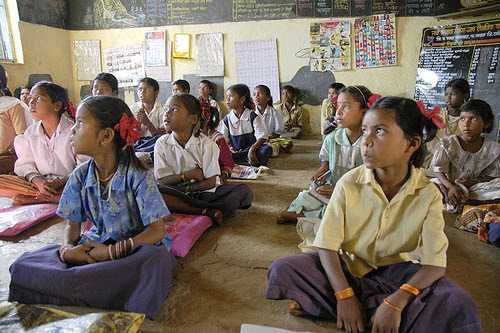
Education has been recognized as an important agent of change. However, as Kolhatkar (2012) notes, education can itself be on the receiving end of a multitude of factors operating in the society, making it both a facilitator as well as a consequence of change. The most direct and significant implication of the same is the space that it creates for the state to intervene in varying aspects and ensure that quality education is accessible to everyone. While this remains an undeniable basis for most nations, it is even more relevant for a vast and developing country like India. The history of education in the Indian context is nearly 5,000 years old with rich legacies of literary and cultural pursuits. However, it was only in the 19th century during the colonial era when the first modern university was built by the British with the purpose of training professionals for their administration. Today, India is home to almost 1,000 universities with over 35 million students, making it the second largest higher education system in the world after China. This ever-advancing field of education often comes to grapple with another core principle enshrined in the Indian Constitution – Cooperative Federalism, also known as the Marble-Cake Federalism.
The roots of the complex interrelation of education with federalism can be traced back to the colonial rule when the Calcutta University Commission was formed to analyze certain aspects of university education. Alternatively known as the Sadler Commission after the name of its chairman, Dr. Michael E. Sadler, the Vice Chancellor of the University of Leeds, the commission, for the first time, included education under the State List, along with giving considerable coordination powers to the Centre. Although the concerns were restricted only to the Calcutta University, it did have far reaching consequences as a result of showcasing significant and relevant findings for most universities spread across the country. This trend was taken forth by the founding fathers of our Constitution who made the Union responsible for coordinating among educational institutions, ensuring equity, and maintaining standards in higher education and research. Additionally, the Centre was viewed as a facilitator of the education needs of the underserved sections of the society, as mentioned in the Directive Principles of State Policy. Further, some powers related to the economic and social planning in education were also given to the Union. These were found to be replicated in practice as the central government strived to maintain over 1,000 schools for students, irrespective of their socio-economic status, including those focusing on elementary as well as secondary education. Thus, despite being under the State List from the very beginning, the contours continued to remain highly fluid.
The game changing revamp occurred in 1976 as part of the 42nd Amendment Act, when the division of powers between the State and the Centre was balanced in such a way so as to make the latter more powerful. This amendment essentially shifted education to the Concurrent list, making both sides as equal partners. This implied that although the States and the Centre could formulate their own legislations regarding matters pertaining to education, the laws of the union government would prevail, in case of any disagreements or disputes. These trends, biased towards the centre, were further advanced by the National Policy on Education (NPE), which was passed in the year 1986. The NPE bestowed statutory status upon national level regulatory bodies such as the National Council for Teacher Education (NCTE) and All India Council for Technical Education (AICTE). Another critical point emerged in the form of the enactment of the 2009 Right to Education (RTE) Act, which made free and compulsory education a fundamental right for children in the age group of 6 to 14 years. This had a direct influence on furthering the role of the Central government in education planning, finance and regulation. In addition to these legislations, the Union government has been instrumental in maintaining its hold over the same through its schemes, including the central sector as well as the centrally sponsored ones. For instance, the Integrated Child Development Services Programme (ICDS) launched in the year 1975 has expanded the scope of functioning of the Union in elementary school education.
On similar lines, the flagship programme – Sarva Shiksha Abhiyan (SSA), aimed at achieving quality and universal elementary education, has made the Centre an important player in framing the policy priorities for States. More specifically, a major proportion of the State’s budget for elementary education is now being used to pay for the teachers’ salaries. This barely leaves the States with the required budget for other non-wage related activities, making them dependent on the Union. Moreover, in practice, the dominance of the SSA authorities has increased, who have failed to recognize the distinct shades of federalism prevalent in various parts of the country, thus undermining state-specific needs and priorities. This flawed one size fits all version comes to light even in the process of decision-making for state-specific budget allocation and structured planning. A pre-determined annual grant, along with performance-based incentives has been suggested by many scholars to rectify the same. This turf between the State and the Union has been evident even in the sphere of the curriculum, with many petitions and discourse being initiated around the practicality of establishing a one-nation-one-board system in place.
Years later, the Union and States are again stuck in a quagmire with the introduction of the National Education Policy (2020) that strives to achieve universalization of education from the pre-school to secondary level. The policy has been denounced for a plethora of reasons. Firstly, there is little doubt regarding the immense influence that the Union is going to have in casting the integral contours of this policy. For instance, the policy proposes to create an amalgamation of the existing regulatory bodies into one to create a singular entity called the Higher Education Commission of India (HECI) to regulate key aspects of education. Similarly, the idea of setting up a National Testing Agency to conduct common aptitude tests for students from all over the country is another highly centralizing instrument, along with giving the Union a clear entry into the university system. Secondly, many have criticized the NEP suggestions such as the three-language formula for being a threat to regional pluralities and a step towards homogenization. This step in the sphere of education, though promising in terms of its originality and futuristic orientation, fails to appreciate the very essence of India; that is, its diversity, thereby undermining the principle of cooperative federalism. Overall, there is a dire need for extensive collaboration between the Centre and the States in the decision-making process regarding vital components of the NEP as well as all other policies in this area. As an example, the realization of the proposed National Assessment Agency called PARAKH or Performance Assessment, Review, and Analysis of Knowledge for Holistic Development would involve consultation to reach consensus among numerous education boards across the country. It is only decentralization in the real sense with the right intentions that can create an effective alliance between the Union and the States as well as improve the country’s educational outcomes.
Supriya is currently pursuing a Bachelors degree in Psychology from Lady Shri Ram College for Women. A self confessed bibliophile, books are her constant source of solace. She finds it liberating to express her ideas through various forms of art.



Hi, Neat post. There’s a problem with your site in internet explorer, would check this?IE still is the market leader and a good portion of people will miss your excellent writing because of this problem.
Can I just say what a aid to find somebody who truly knows what theyre talking about on the internet. You definitely know how you can bring a difficulty to mild and make it important. Extra folks have to read this and perceive this aspect of the story. I cant believe youre no more widespread because you positively have the gift.